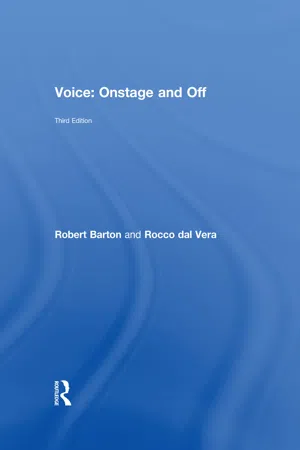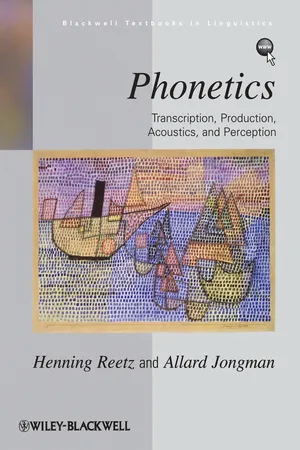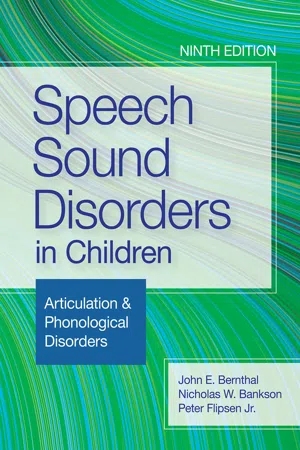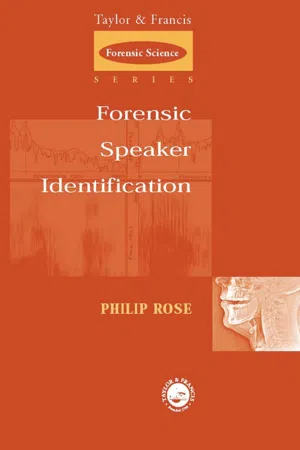Languages & Linguistics
Velar
Velar refers to a speech sound produced by raising the back of the tongue against the soft palate. In phonetics, velar sounds are articulated using the velum, and they are commonly found in languages around the world. Examples of velar sounds include the "k" and "g" sounds in English, as in the words "kite" and "go."
Written by Perlego with AI-assistance
6 Key excerpts on "Velar"
- eBook - ePub
- Robert Barton, Rocco dal Vera(Authors)
- 2017(Publication Date)
- Routledge(Publisher)
Lateral : consonants formed with the tip of the tongue in contact with the roof of the mouth, so that air flows around the sides of the tongue [l, ł].Lingual : related to the tongue.Nasal : resonating in the nasal cavity [m, n, ɳ].Palatal : an articulation involving the tongue and the hard palate [j].Pharyngeal : an articulation involving the root of the tongue and the back wall of the pharynx.Plosive : having a popping quality [p, b, t, d, k, g, ?].Postalveolar : an articulation with the tongue near the back side of the alveolar ridge [ʃ, ʒ].Retroflex : the tip of the tongue lifted and pulled backward [r, ɚ, ɝ].Stop : a consonant that abruptly cuts off the flow of sound [p, b, t, d, k, g, ?].Tap or flap : when one articulator (usually the tongue tip) is drawn back and then allowed to strike against another.Trill : when one articulator is held loosely near another so that the flow of air between them sets them in motion, alternately sucking them together and blowing them apart.Uvular : an articulation involving the back of the tongue and the uvula.Velar [ˈvi.lɚ(ə)]: related to the soft palate or velum at the back of the roof of the mouth [k, g, ɳ].Take the time to find and know the location of these specific articulation places in your mouth. You will probably be asked to make subtle adjustments in the way certain sounds are formed. Even if your articulation is naturally perfect you will need to shift it for accent and character voice work. Knowing your way around your mouth will make those adjustments easier and quicker.Consonants are formed by a specific relationship of your articulators. Can you figure out the consonant being made if you are told it is a bilabial (two lips), voiced (vocal folds vibrating), nasal (air moves through your nose), and continuant (sound continues as long as you like)? Did you guess [m]?When we set out to describe consonants, we ask certain questions: How do we use the air stream? - eBook - ePub
- Steve Kleinedler(Author)
- 2018(Publication Date)
- Routledge(Publisher)
pat , the vocal folds don’t vibrate.This stream of expelled air is modified by parts of your body in your mouth and near the inside of your mouth. (The inside of your mouth is also called the ORAL CAVITY .) The parts of the body that modify this air stream are called ARTICULATORS . These articulators include the:- lips,
- teeth,
- tongue,
- HARD PALATE (the bony part of the roof of your mouth),
- SOFT PALATE (the soft part of the roof of your mouth past the bony part – this part is also called the VELUM ), and
- PHARYNX (the part of your mouth past the soft palate but before the esophagus).
One way that consonants are categorized is by the place in the mouth where they are articulated.Something you can do!- With the tip of your tongue, touch your lips, teeth, and hard palate.
- Raise the broad, flat part of your tongue or the back of your tongue to meet the soft palate.
- Pull the back of your tongue backward past the soft palate to meet the pharynx.
- What happens when you try to make sounds when your tongue is in each of these positions? We’ll return to this exercise again at the end of the chapter.
- Consonants that are articulated with the lips are called LABIALS . They include [p], [b], and [m].
- Consonants that are articulated with the tongue against the ridge of the roof of your mouth, just above your upper teeth, are called ALVE OLARS . They include [t], [d], and [n]. (This ridge is where the sockets of your teeth are located in the jaw. It is called the ALVEOLAR RIDGE .)
- Consonants that are articulated when the tongue and the velum meet are called VelarS . They include [k], [g], and [ŋ] (the sound represented by the letters ‘ng’ in words like runni ng .) In English, [ŋ] never appears at the beginning of the word; however, in many other languages, it can.2
2.2 Kinds of speech soundsShortly after you learned the alphabet, you were likely taught that the letters of the alphabet were either consonants or vowels. Generally speaking, a VOWEL is created when you produce a steady, unobstructed flow of air. When you produce a CONSONANT - eBook - ePub
Phonetics
Transcription, Production, Acoustics, and Perception
- Henning Reetz, Allard Jongman(Authors)
- 2011(Publication Date)
- Wiley-Blackwell(Publisher)
palatal sounds.5 Velum. This is the soft muscular rear part of the roof of the mouth, also known as the soft palate. Sounds produced here are known as Velar sounds. The velum also serves another purpose in the production of speech sounds. It can be raised to close off the nasal cavity from the rest of the vocal tract, for example during oral breathing. In this case, air can only escape through the mouth. This closing of the nasal cavity is known as the velic or velopharyngeal closure. Sounds produced with a raised velum are called oral sounds. When the velum is lowered, the passage between the nasal and oral cavities is open, as in nasal breathing. Air can now go out through the nose and the mouth, producing in this way nasal or nasalized sounds (see Section 3.4.2.2 for a discussion of the difference between nasal and nasalized sounds). If, in addition to lowering the velum, the airstream is blocked from flowing out of the oral cavity, the air can only escape through the nasal cavity. In this case a nasal stop is produced.6 Uvula. This is a small wedge-shaped object hanging down from the end of the velum. It can be seen when looking in the mirror with the mouth wide open and keeping the tongue low and flat or holding it down with a tongue depressor, as when saying “aaa” at the doctor’s office. Sounds produced here are known as uvular sounds.7 Pharynx. This is the cavity between the uvula and the larynx, in everyday language referred to as the throat. The back wall of the pharynx can be considered an articulator on the upper surface of the vocal tract. Sounds produced here are known as pharyngeal sounds.After reviewing these parts of the upper surface of the vocal tract and before going over the lower surface of the vocal tract, we should discuss what in common terms is known as the “voice box.”8 Larynx. Usually this is the source of all voiced sounds. But the vocal folds in the larynx can also be the narrowest constriction in the production of a speech sound and hence the larynx can also serve as an articulator. Sounds produced in this way are called glottal sounds - eBook - ePub
Speech Sound Disorders in Children
Articulation & Phonological Disorders
- John E Bernthal, Nicholas W Bankson, Peter Flipsen(Authors)
- 2021(Publication Date)
- Brookes Publishing(Publisher)
For example, to say the word stop, a speaker’s brain must send nerve instructions, in the proper sequence, to the muscles of the respiratory system, larynx, tongue, lips, and velopharynx. The full understanding of speech production therefore involves a knowledge of phonology (the study of how sounds are put together to form words and other linguistic units), articulatory phonetics (the study of how the articulators make individual sounds), acoustic phonetics (the study of the relationship between articulation and the acoustic signal of speech), and speech perception (the study of how phonetic decisions are made from the acoustic signal). Vowel Articulation: Traditional Phonetic Description A vowel sound is usually formed as sound energy from the vibrating vocal folds escapes through a relatively open vocal tract of a particular shape. Because a syllable must contain a vowel or vowel-like sound, vowels sometimes are called syllable nuclei. Each vowel has a characteristic vocal tract shape that is determined by the position of the tongue, jaw, and lips. Although other parts of the vocal tract, like the velum, pharyngeal walls, and cheeks, may vary somewhat with different vowels, the positions of the tongue, jaw, and lips are of primary consequence. Therefore, individual vowels can be described by specifying the articulatory positions of tongue, jaw, and lips. Furthermore, because the jaw and tongue usually work together to increase or reduce the mouth opening (Figure 2.4), for general phonetic purposes, vowel production can be described by specifying the positions of just two articulators, tongue and lips - eBook - ePub
- Phil Rose(Author)
- 2002(Publication Date)
- CRC Press(Publisher)
alveolar for post-alveolar affricates and fricatives.Figure 6.9 Mid-sagittal section of vocal tract showing some common active (capitals) and passive (italics) articulatorsEnglish consonants
Almost enough of the architecture of basic articulatory description has now been covered to present, in Table 6.2, a table of the commonly occurring consonantal sounds in English. It is possible to do this because there is not very much variation in consonants across the main varieties of English (Ladefoged 2001: 47).In Table 6.2, the sounds are arranged in a Place–Manner matrix (Place horizontally, Manner vertically). For each sound, a word is given that typically contains it. Some cells in the matrix contain symbols for more than one sound. These sounds differ along other phonetic parameters, the most common of which is voicing. Thus ofTable 6.2 Major consonantal sounds of Englishthe two sounds in the labio-dental fricative cell [f] is voiceless and [v] voiced, and of the two sounds in the bilabial plosive cell [p] is voiceless and [b] voiced. As far as the English plosives go, it is somewhat of an oversimplification to say there are only two phonetic variants, and that they differ in voicing. This will be taken up later.Table 6.2 shows that phonetically English has plosives at three places: bilabial, alveolar and Velar, plus affricates at the post-alveolar place (these are commonly referred to as palato-alveolar, or even palatal, affricates).Phonetically, there are fricatives at five different places; nasals at four places; one lateral; one rhotic (‘r’ sound); and two semivowels. Except for the higher number of fricatives at the front of the mouth (labio-dental, dental and alveolar), this is a fairly typical phonetic consonantal inventory. - eBook - ePub
- Bruce M. Rowe, Diane P. Levine(Authors)
- 2022(Publication Date)
- Routledge(Publisher)
pharyngeal sound. These are just some of the many additional possibilities for places of articulation.Consonants: manner of articulation
The airstream can be obstructed at any place along the vocal tract. However, you will note that many sounds can be articulated at about the same location. For instance, there are five egressive voiced alveolar sounds in English. They must differ in some other characteristic. The additional difference is the manner in which the airstream is constricted or released within the vocal tract.Nasals are produced in both the nasal and oral cavities. Most sounds in English are produced through the oral (mouth) cavity. This occurs because during speech, the velum (soft palate) is usually in a raised position, blocking the airstream’s passage into the nasal cavity. The resultant sounds are called oral because the oral cavity is used as the sole resonating chamber. However, if the velum is lowered, air can escape through both the oral and nasal cavities. The sound that results is called nasal. There are only three nasal consonants in English: the initial sound in mad [m] (bilabial) and nose [n] (alveolar), and the final sound in sing [ŋ] (Velar).When you have a cold, people may comment that you sound nasal. However, if your nose is completely blocked, then you cannot produce nasal sounds. All your sounds would be oral, and it would be more accurate to label your speech as oral, not nasal. For instance, when your nose is blocked, the utterance “How come I sound so funny?” becomes “How cub I soud so fuddy?” The oral [b] sound is substituted for the nasal [m], and the oral [d] sound is substituted for the nasal [n] sound. The only difference between [b] and [m], as well as [d] and [n], is that the first sound is oral and the second is nasal.
Index pages curate the most relevant extracts from our library of academic textbooks. They’ve been created using an in-house natural language model (NLM), each adding context and meaning to key research topics.
Explore more topic indexes
Explore more topic indexes
1 of 6
Explore more topic indexes
1 of 4





